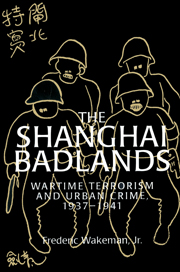Book contents
- Frontmatter
- Contents
- Dedication
- Acknowledgments
- Glossary
- Shanghai, 1940
- Metropolitan Shanghai
- Dedication
- Prologue: Consequences
- 1 Island Shanghai
- 2 Blue Shirts
- 3 National salvation
- 4 Retaliation: Pro-Japanese terrorism
- 5 Provocation: The Chen Lu assassination
- 6 Capitulation: The Xi Shitai assassination
- 7 The puppet police and 76 Jessfield Road
- 8 Terrorism and crime
- 9 Rackets
- 10 Terrorist wars
- 11 Dimout
- Epilogue: Outcomes
- Abbreviations
- Notes
- Bibliography
- Index
2 - Blue Shirts
Published online by Cambridge University Press: 02 November 2009
- Frontmatter
- Contents
- Dedication
- Acknowledgments
- Glossary
- Shanghai, 1940
- Metropolitan Shanghai
- Dedication
- Prologue: Consequences
- 1 Island Shanghai
- 2 Blue Shirts
- 3 National salvation
- 4 Retaliation: Pro-Japanese terrorism
- 5 Provocation: The Chen Lu assassination
- 6 Capitulation: The Xi Shitai assassination
- 7 The puppet police and 76 Jessfield Road
- 8 Terrorism and crime
- 9 Rackets
- 10 Terrorist wars
- 11 Dimout
- Epilogue: Outcomes
- Abbreviations
- Notes
- Bibliography
- Index
Summary
Foreign observers detected a strong wave of “patriotic sentiment” in Shanghai during June 1938. Chinese Nationalist flags were flown on all anniversaries. The “mosquito press” published jingoistic editorials. Regular newspaper articles urged young people to join or organize guerrilla bands. On June 10 the first of seven terrorist attacks on collaborators occurred. You Yaosun, a cotton broker who belonged to the Japanese-sponsored Shanghai Citizens Association, was wounded and one of his Russian bodyguards was killed. The next day a minor Reform Government official was wounded. On June 18, the land commissioner of the puppet government, Ren Bau'an, was killed at a party of Chinese collaborators and Japanese friends. Six days later one man was killed in a lawyer's office, and four of You Yaosun's friends were shot in a hotel room. The day after that, Gu Qingyi, a cereal merchant who was also a member of the Shanghai Citizens Association, was assassinated. On June 29 assassins disguised as beggars shot and killed Chen Deming, chief of the puppets' boat inspection office.
The public had a number of theories to account for the terrorist wave. There were some indications of a falling out between rival groups of collaborators, each trying to win Japanese political favor and monetary support. People speculated that these patriotically disguised deeds were actually struggles over the spoils of Japanese victory. Others thought that they were revenge killings by disgruntled rice dealers or boatmen enraged by the onerous taxes collected by the boat inspectors. “The consensus of opinion was, however, that there was a Chinese Nationalist organization functioning in Shanghai and that these killings were all patriotic in motive.”
- Type
- Chapter
- Information
- The Shanghai BadlandsWartime Terrorism and Urban Crime, 1937–1941, pp. 17 - 26Publisher: Cambridge University PressPrint publication year: 1996

